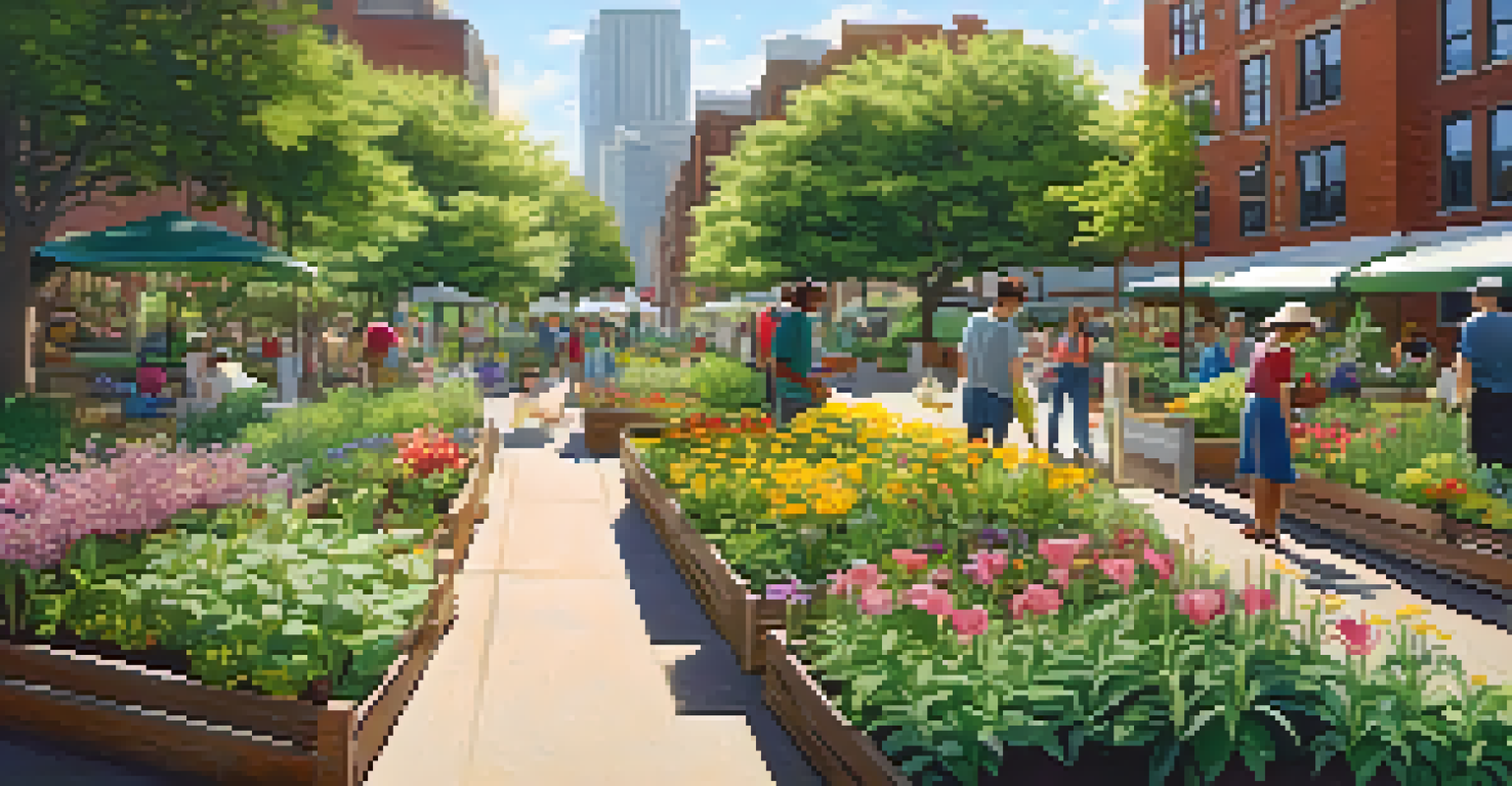The Effect of Urbanization on Illinois' Natural Habitats

Understanding Urbanization in Illinois
Urbanization refers to the increasing population in cities and towns, leading to the expansion of urban areas. In Illinois, major cities like Chicago have grown significantly, impacting the surrounding environments. As more people move into these urban centers, natural landscapes are altered to accommodate housing, infrastructure, and services.
The health of our ecosystems is directly tied to the health of our cities.
This transformation often leads to the replacement of forests, wetlands, and prairies with concrete and asphalt. As a result, the natural habitats that once thrived in these areas face significant challenges. Understanding urbanization is crucial to grasping its effects on Illinois' ecosystems.
To visualize this, think of a once lush forest being replaced by a bustling shopping center. While urbanization can bring economic benefits, it comes at a cost to our natural world.
Loss of Natural Habitats and Biodiversity
One of the most concerning effects of urbanization is the loss of natural habitats. As cities expand, vital ecosystems are often destroyed or fragmented, leaving wildlife with fewer places to live and thrive. This loss of habitat poses a significant threat to local species, many of which are already endangered.

Biodiversity, which refers to the variety of life in a particular habitat, suffers greatly from urban development. For instance, the conversion of wetlands into residential areas can lead to the decline of species that rely on these crucial ecosystems for survival. Without these habitats, many plants and animals struggle to adapt to the changing environment.
Urbanization Alters Natural Landscapes
As cities like Chicago expand, natural habitats are replaced by urban infrastructure, leading to ecological challenges.
Imagine if your home were suddenly replaced by a high-rise building; this is what many species face as urbanization continues to encroach on their habitats.
Fragmentation of Ecosystems and Its Effects
Urbanization often leads to habitat fragmentation, where large, continuous habitats are broken into smaller, isolated patches. This can have dire consequences for wildlife, as animals may find it difficult to move between these patches to find food, mates, or shelter. Fragmentation can create 'urban islands' that are inhospitable for many species.
In every walk with nature one receives far more than he seeks.
For example, when forests are cut down for development, the remaining trees may not support the same diversity of wildlife as before. Animals like deer or foxes may avoid these fragmented areas, leading to a decline in their populations. The interconnectedness of ecosystems is essential for maintaining biodiversity.
Think of it like a road cutting through a forest; the animals on either side may never meet, which disrupts the natural balance of the ecosystem.
Impact on Water Quality and Supply
Urbanization significantly impacts water quality and supply, largely due to increased runoff and pollution. As impervious surfaces like roads and buildings replace natural landscapes, rainwater cannot be absorbed into the ground. Instead, it flows over these surfaces, picking up pollutants and debris before entering rivers and lakes.
In Illinois, this can lead to the contamination of water sources, negatively affecting both wildlife and human populations. Polluted water can harm aquatic ecosystems, leading to a decline in fish populations and other species. Additionally, urban areas often experience higher flooding risks due to inadequate drainage systems.
Habitat Loss Threatens Biodiversity
Urban development results in the destruction and fragmentation of ecosystems, significantly threatening local wildlife and biodiversity.
Consider how a sponge works; when it’s dry, it absorbs water easily. But when it’s saturated, it can’t hold any more. Urbanization has a similar effect on our landscapes, compromising their ability to manage water.
Climate Change and Urban Areas
Urbanization contributes to climate change, which in turn affects natural habitats in Illinois. Cities tend to be 'heat islands,' where temperatures are significantly higher than surrounding rural areas. This temperature increase can alter local weather patterns and impact plant and animal life.
For example, many species rely on specific temperature ranges for breeding and feeding. When urban heat alters these conditions, it can disrupt migration patterns and breeding cycles. Additionally, urbanization can lead to increased greenhouse gas emissions, further exacerbating climate change.
Think of it like wearing a heavy coat on a warm day; the discomfort can throw off your plans. Similarly, the changes in climate can create a ripple effect that disrupts the delicate balance of ecosystems.
Conservation Efforts in Urban Areas
In response to the challenges posed by urbanization, various conservation efforts have emerged in Illinois. These initiatives aim to restore natural habitats and protect existing ecosystems. For instance, community gardens and urban parks provide vital green spaces that support biodiversity and connect residents with nature.
Organizations are also working to create wildlife corridors that allow animals to move safely between fragmented habitats. These corridors can help maintain genetic diversity and ensure populations remain viable. Education and community involvement are crucial components of these efforts, fostering a sense of stewardship for local environments.
Conservation Efforts Are Vital
To combat the impacts of urbanization, community initiatives and wildlife corridors aim to restore habitats and support ecological health.
Imagine planting a tree in your neighborhood; it not only beautifies the area but also provides shelter for birds and other wildlife. Small actions can lead to significant positive changes in urban ecosystems.
The Future of Illinois' Natural Habitats
Looking ahead, the future of Illinois' natural habitats depends largely on our choices today. Balancing urban development with environmental preservation is crucial for maintaining biodiversity and ecosystem health. As cities continue to grow, it is essential to prioritize sustainable practices that protect natural resources.
Innovative urban planning that incorporates green spaces, efficient water management, and wildlife-friendly designs can help mitigate the negative effects of urbanization. By fostering a culture of conservation, we can ensure that future generations inherit a healthy, diverse environment.

Think of it as planting seeds today for a flourishing garden tomorrow. With mindful efforts, we can cultivate a vibrant harmony between urban life and nature.